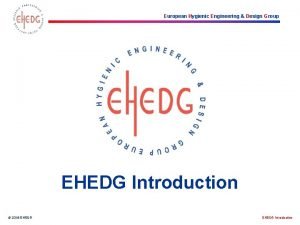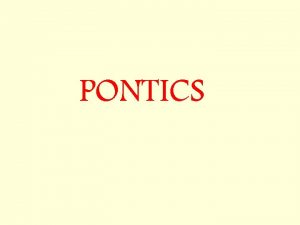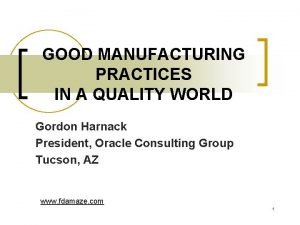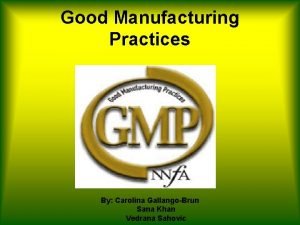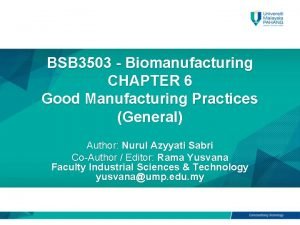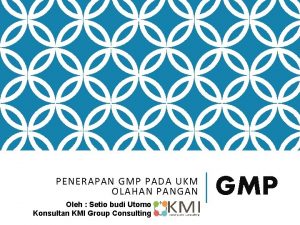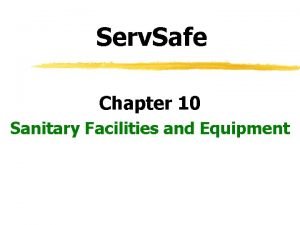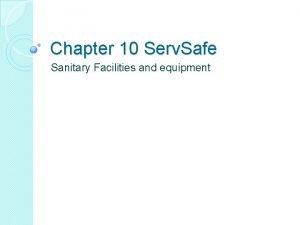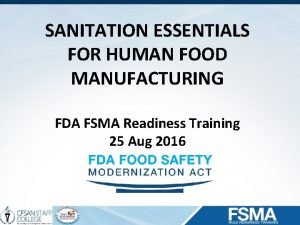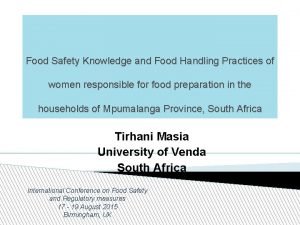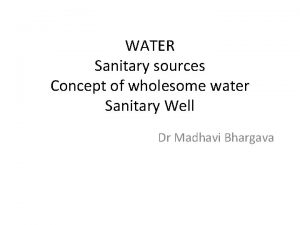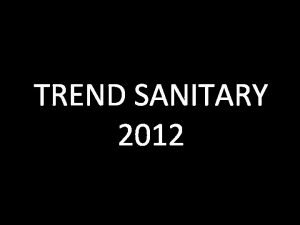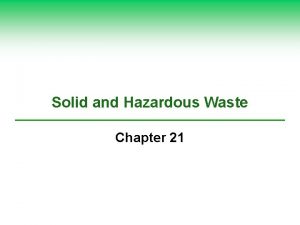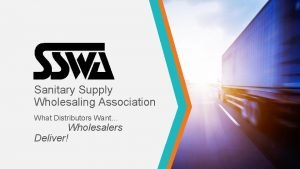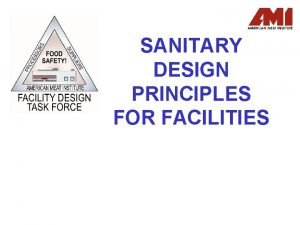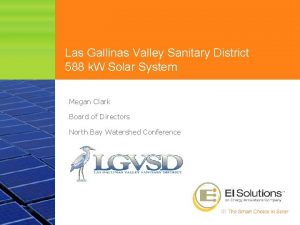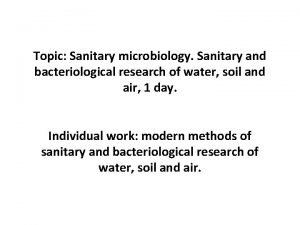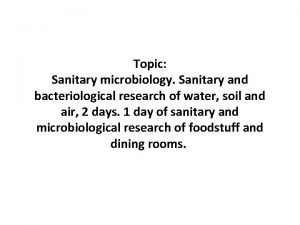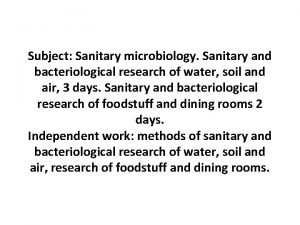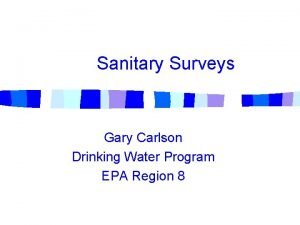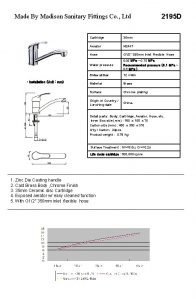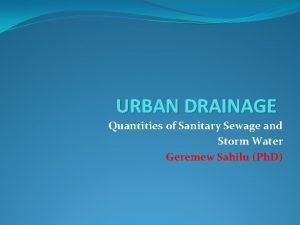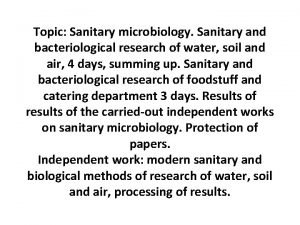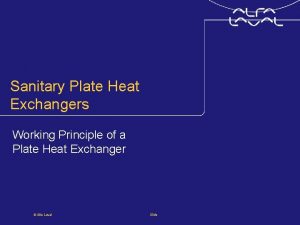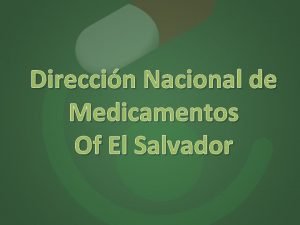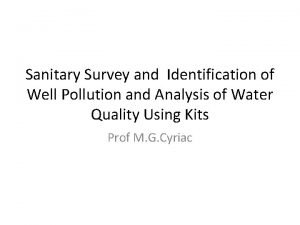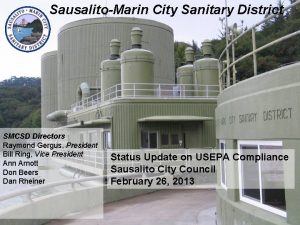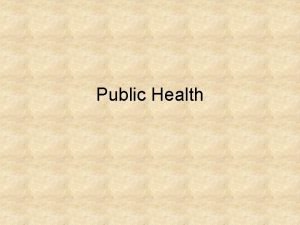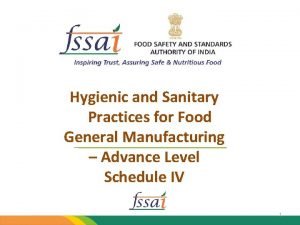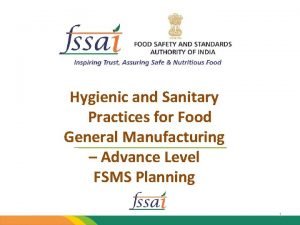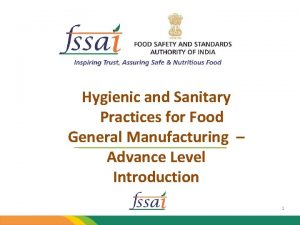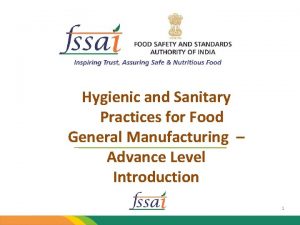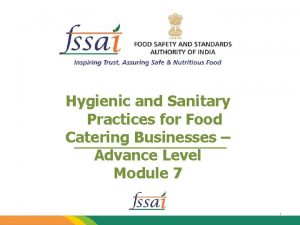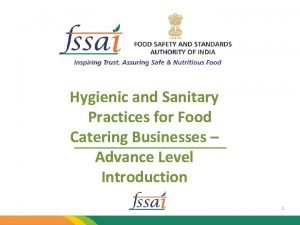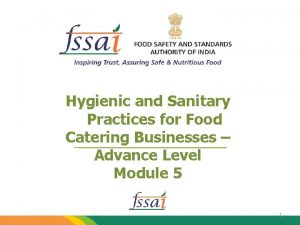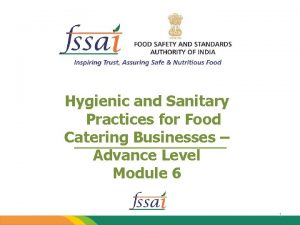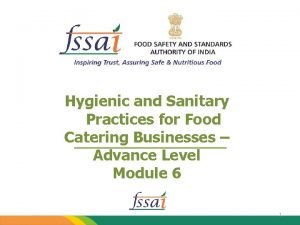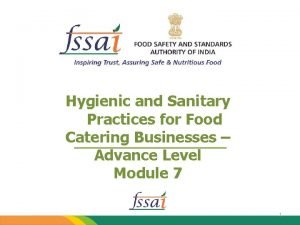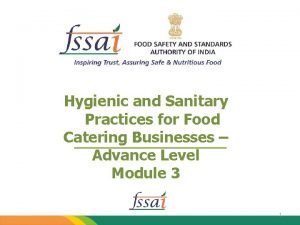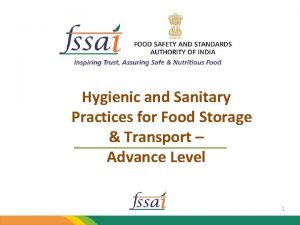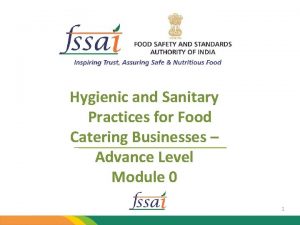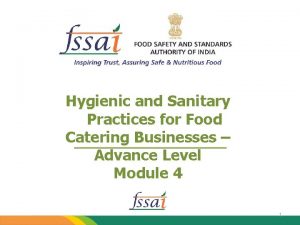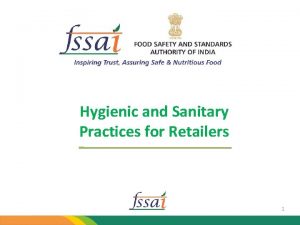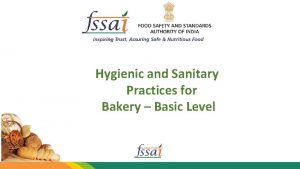Hygienic and Sanitary Practices for Food General Manufacturing















































- Slides: 47

Hygienic and Sanitary Practices for Food General Manufacturing – Advance Level Schedule IV 1

Introduction to Food Safety means assurance that food is acceptable for human consumption according to its intended use. Food Safety Management System means the adoption Good Manufacturing Practices, Good Hygienic Practices, Hazard Analysis and Critical Control Point and such other practices as may be specified by regulation, for the food business. 2

PART II – LOCATION, LAYOUT & FACILITIES Location & surroundings Layout & design of food establishment premises Equipment & containers Facilities Water Supply Drainage & Waste disposal Personnel facilities and toilets Air quality and ventilation Lighting 3

Location and Surroundings Location shall be: ü away from environmentally polluted areas ü away from industrial activities which produce: - Disagreeable or obnoxious odor, - Fumes - Excessive Soot - Dust - Smoke - Chemical or biological emissions - Pollutants 4

Layout & design of food establishment premises Facility in good condition to conditionleads lead to clean, pest free environment • Repaired or replaces holes, broken tiles missing ceiling panel etc. • Sealed/ grated sewer grids less than ¼ inch Hole free exterior walls • Louvers in exterior wall fans that close tightly when turned off • Screened pipes & windows • Sealed outside pipe Striped or sealed gaps around all doors • Use of screen door, air curtains & other mechanisms • Sealed cracks to prevent insect harborage 5 5

Equipment & Containers – made up of non-corrosive / rust free material – smooth, free from any grooves – easy to clean and maintain – non-toxic and non-reactive – of food grade quality 6

Facilities Water Supply Drainage & Waste disposal Personnel facilities and toilets Air quality and ventilation Lighting 7

Water Supply: - Only potable water meeting BIS standards - Appropriate facilities for storage and distribution of water - Periodic cleaning of storage tanks and its record - Non-potable water, if used, only for cooling of equipment, steam production, fire fighting 8

Drainage and waste disposal - Disposal of sewage and effluent in conformance with the requirements of Factory/ EPCB - Designed and constructed to reduce risk of contamination to food and potable water 9

Personal facilities and toilets: - Facilities for washing and drying hands - Supply of hot and cold water - Separate lavatories of appropriate hygiene design for males and females separately - Suitably located Changing facilities for 10

Ventilation & Lighting ü Air quality and ventilation: - Natural / mechanical ventilation system including air filters, exhaust fans - Designed and constructed as such air does not flow from contaminated areas to clean areas 11

PART III – CLEANING & MAINTENANCE OF ESTABLISHMENT Cleaning and Sanitation Maintenance of Facility 12

Cleaning and Sanitation Facilities should permit effective cleaning. Cleaning Program • areas to be cleaned, • cleaning frequency, • procedure, • equipment, • cleaning material and method 13

Maintenance • Preventive and Corrective Maintenance • Lubricants and heat transfer fluids shall be food compatible Procedure for releasing maintained equipment back to production • Maintenance personnel shall be trained in the product hazards associated with their activities 14

PART IV – PEST CONTROL ♦ Pest Control Ø Preventing access Ø Harborage & infestation Ø Monitoring & detection Ø Eradication 15

PEST CONTROL PRECAUTIONS • Report pest infestations immediately. • Do not use pesticides/insecticides in food processing area. 16

PEST CONTROL 17

PEST CONTROL Location of Rat Traps 18

PART V – PERSONAL HYGIENE Health status Behavioral & Personal Cleanliness Visitors 19

Health status - - Personnel suffering from disease or illness shall not be allowed to enter in food handling area System to report illness or symptoms of illness to management - - - Medical examination of food handlers/ employees once in a year Records of medical examination Factory shall be compulsorily inoculated against the entire group of diseases and recorded In case of epidemic, all workers to be vaccinated irrespective of the yearly vaccination. 20

Behavioral & Personal Cleanliness ü Personal Cleanliness: - High degree of personal cleanliness by food handlers - Food business shall provide to all food handlers; • Protective clothing • Head covering • Face mask • Gloves • Foot wear 21

Visitors - Generally visitors should be discouraged to go in side the food handling areas - The food business shall ensure visitors to its food manufacturing/ handling areas shall; • Wear protective clothing • Footwear • Adhere to personal hygiene provisions envisaged in the respective section 22

PART VI – CONTROL OF OPERATIONS Procurement of raw materials Storage of raw material Production Product Packaging Approved additives 23

Procurement of Raw Materials: - Quality raw materials (free of parasites, micro-organisms, pesticides etc) - Raw material conforming to the regulations under the act - Records of raw material as source of procurement 24

Storage of Raw materials and Food: - Adequate food storage facilities to protect food from contamination - Cold storage facilities according to requirement - Segregation of storage area for raw and processed food, recalled materials, packaging materials, stationary, cleaning materials/ chemicals - Separate cold storage of Raw food like meat/ poultry/ seafood product away from the area of WIP , processed , cooked and packaged products. - Monitoring of temperature and humidity - FIFO - Non –toxic containers for food storage - Stored on racks or pallets well above the floor and away from the wall 25

Food processing/ preparation, packaging and distribution/ service: - Effective time and temperature control of receiving, processing, cooking, cooling, storage, packaging, distribution and food service - care while handling/ transporting frozen food/ raw materials - Monitoring record of time 26

Food Additives 27

Food Additives 28

Food Additives APPENDIX B MICROBIOLOGICAL STANDARDS 29

Food packaging - Adequate packaging material - Labeling as per FSSA - Only food grade packaging material like aluminum, plastic, tin - Non-toxic gases, if used for packaging 30

PART VII – FOOD TRANSPORTATION, STORAGE & DISTRIBUTION Transportation Storage Distribution 31

Transportation Food shall be adequately covered during transportation to assure food safety. Transportation vehicles Ø Vehicle inspection Ø Shall not contaminate foods & packaging Ø Should be easy to clean and maintain Ø Provide effective protection from dust & dirt Ø If required maintain temperature, humidity, atmosphere Ø If required allow monitoring of temperature, humidity, etc. Ø Should be used only for carrying food. Ø Regular maintenance of vehicles is required. 32

Food distribution/ service - Appropriate supply chain to minimize food spoilage - Non-toxic, clean, well maintained food containers during transportation - Temperature and humidity control during 33

PART VIII – MANAGEMENT & SUPERVISION Management & Supervision Provision of resources to implement & maintain Food Safety Developing SOPs for processing, packing, dispatch & storage of food Competent Technical Managers & Supervisors - having skills on food hygiene principles & practice - taking appropriate preventive & corrective action - ensure effective monitoring and supervision. Maintaining Process related records (e. g. production records) 34

PART IX – FOOD TESTING Sampling Quality Testing Parameters Safety Testing Parameters 35

Sampling & Testing Ø Presence of at least two witnesses at the time of lifting the sample Ø Witnesses must put their signatures on the form and other documents prepared while sampling. Ø Notice to be given to the manufacturer, distributor or supplier Ø Food Safety Officer or the Purchaser must pay the cost of the sample as per MRP Ø Sample of food article should be taken in clean dry bottles or jars Ø Sample to be sealed to avoid leakage, evaporation, entrance of moisture or other contaminants. 36

PART X - Training Awareness & responsibilities Training Programmes Ø Nature of food Ø Control Spoilage Ø Handling of food Ø Storage Training Records Instruction & supervision Ø Periodic assessment of training & effectiveness Refresher training 37

PART XI – AUDIT, DOCUMENTATION & RECORDS Audit Documentation and Record Keeping 38

AUDIT Audit At planned interval to determine gap in the GMP/GHP system Records to be retained for 1 year or shelf life of product (whichever is more) Audit program shall be planned taking into consideration Importance of process to be audited Results of previous audit Audit criteria, scope, frequency and methods to be defined Documented procedures Records of the audit & their results to be well maintained Immediate actions to be taken to eliminate detected non-conformities & their causes. 39

DOCUMENTATION & RECORDS Documentation & Record keeping Temperature & Process control Calibration of Temperature indicators Pest Control records Personnel Hygiene Cleaning, sanitation & maintenance Process related records (e. g. production records) 40

PART XII - Product Information & Consumer Awareness Batch Identification Ø Identifies producer Ø Product recall Ø Effective stock rotation - FIFO Product Information Ø Adequate information & enables other person in food chain to handle, display, store, prepare & use the product safely & correctly Labeling Ø Should confirm to Legal Requirements Consumer Education 41

Product Labeling 42

SCHEDULE 4 ACTIVITY Give any 2 examples of Personal Hygiene? Which is the right picture amongst the two !! Food Handlers should practice GOOD HAND WASHING? YES or NO ? 43

SCHEDULE 4 ACTIVITY Wear clean and appropriate protective clothing? YES or NO? Rings, necklaces & watches are permitted in Food Industry? YES or NO ? Always wash your hands with ____ and water !!! Demonstrate: Sequence of wearing appropriate protective clothing. 44

SCHEDULE 4 ACTIVITY Give any 2 examples of Protective Clothing? Cleaning and Sanitation is necessary? YES or NO ? Coughing or Sneezing on open food leads to contamination? YES or NO ? Demonstrate: How to wash hands properly? 45

SCHEDULE 4 ACTIVITY Point out what is wrong in the picture given !! 46

End of Session……. 47
 European hygienic engineering & design group
European hygienic engineering & design group Conical pontic
Conical pontic Modified ridge lap
Modified ridge lap Manufacturing cost vs non manufacturing cost
Manufacturing cost vs non manufacturing cost Process vs job costing
Process vs job costing Manufacturing cost vs non manufacturing cost
Manufacturing cost vs non manufacturing cost Manufacturing cost vs non manufacturing cost
Manufacturing cost vs non manufacturing cost Additively
Additively Apa itu gmp
Apa itu gmp Good manufacturing practices in pharmaceutical industry
Good manufacturing practices in pharmaceutical industry Gmp meaning
Gmp meaning Elemen cppob
Elemen cppob Pengertian gmp
Pengertian gmp Sanitary facilities and equipment
Sanitary facilities and equipment Unit 2 food food food
Unit 2 food food food Food chain food chain food chain
Food chain food chain food chain Cross connection servsafe
Cross connection servsafe Sanitary landfill advantages and disadvantages
Sanitary landfill advantages and disadvantages Essentials of food sanitation
Essentials of food sanitation Improper food handling practices
Improper food handling practices Define sanitary well
Define sanitary well Sanitary adalah
Sanitary adalah Sanitary landfill
Sanitary landfill Sanitary supplies wholesaler
Sanitary supplies wholesaler 10 principles of sanitary design
10 principles of sanitary design Las gallinas valley sanitary district
Las gallinas valley sanitary district Sanitary microbiology
Sanitary microbiology Microbiology
Microbiology Sanitary microbiology
Sanitary microbiology Epa sanitary survey
Epa sanitary survey Castelli sanitary
Castelli sanitary Difference between dwf and wwf
Difference between dwf and wwf Sanitary microbiology
Sanitary microbiology Standard heat exchanger
Standard heat exchanger Sanitary registration in el salvador
Sanitary registration in el salvador Sanitary survey
Sanitary survey Sanitary landfill
Sanitary landfill Pasco sanitary landfill
Pasco sanitary landfill Sausalito marin city sanitary district
Sausalito marin city sanitary district The sanitary report 1842 bbc bitesize
The sanitary report 1842 bbc bitesize Iso 22301 utbildning
Iso 22301 utbildning Typiska drag för en novell
Typiska drag för en novell Nationell inriktning för artificiell intelligens
Nationell inriktning för artificiell intelligens Vad står k.r.å.k.a.n för
Vad står k.r.å.k.a.n för Varför kallas perioden 1918-1939 för mellankrigstiden
Varför kallas perioden 1918-1939 för mellankrigstiden En lathund för arbete med kontinuitetshantering
En lathund för arbete med kontinuitetshantering Personalliggare bygg undantag
Personalliggare bygg undantag Personlig tidbok för yrkesförare
Personlig tidbok för yrkesförare
